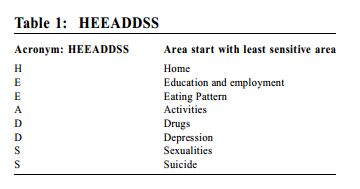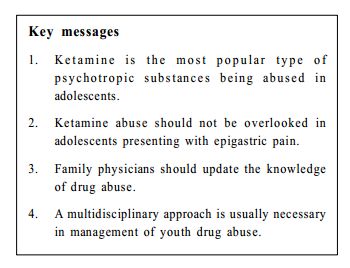
|
September 2009, Volume 31, No. 3
|
Case Report
|
Ketamine abuse: a cause of epigastric pain in adolescentsMing-pong Yiu 姚銘邦, Ching-luen Ng 吳清聯, Yuk-kwan Yiu 姚玉筠 HK Pract 2009;31:135-137 Summary Family physicians frequently encounter patients presenting with acute epigastric pain. The most common diagnoses include gastritis, gastro-oesophageal reflux, viral illness, biliary causes and the red flags like pancreatitis, perforated peptic ulcer and aortic aneurysm. In the entity of adolescent medicine, we should not overlook the possible side effect of ketamine abuse as a cause of epigastric pain. We present in this paper 2 cases of the 10 patients complaining of ketamine related epigastric pain encountered by the first author in general practice and a brief discussion on ketamine abuse in Hong Kong. 摘要 家庭醫生經常碰到急性上腹痛病人求診。常見原因包括 胃炎,胃酸倒流,病毒感染,膽道病變;更嚴重的有胰腺 炎,穿孔性胃腸道潰瘍和主動脈瘤。但在青少年,我們不應 忽略因濫用氯胺酮而引起急性上腹痛的可能性。本文敘述兩 宗因濫服氯胺酮引起上腹痛的個案,並簡單討論在香港濫用 氯胺酮的情況。 Introduction Ke tamine , an N-Me th yl-D-asp arta te r ec ep to r antagonist (NMDA), is a kind of general anaesthetic for use in induction and maintenance in paediatrics patients. Other uses are for sedation in intensive care and analgesic in emergency medicine. However, the recreational use of ketamine, or "street ketamine", is very different from the medical use of ketamine. The street ketamine contains phencyclidine, a close analogue of ketamine but with a longer half-life.1 Street ketamine comes usually in the form of white powder and may be diluted with substances like washing powder, paint flakes, talcum powder, flour, painkillers and barbiturates to increase suppliers' profits. The short-term side-effects of ketamine include increases in heart rate and blood pressure, impaired attention, and even respiratory depression at high doses. The abusers will have sensations of floating outside the body, visual hallucinations, and be in a dream-like state lasting for about 30 to 45 minutes. These "desired" effects often come along with confusion, anterograde amnesia, and delirium.2 Literatures showed illicit use of ketamine will lead to frequency of urination, even at 15 minutes interval. Patients were found to have detrusor overactivity with urinary leakage when the bladder was 30 to 50 mL filled.3 For the worst situation, patients may end up with renal failure and require dialysis or even kidney transplant if they continue to have ketamine abuse. The proposed underlying mechanism is damage to the brain or the spinal cord. Another possible aetiology is an intensive immunological response to street ketamine. Besides, direct toxic effect of ketamine and its metabolites on the lower urinary tract mucosa was an alternative postulation.4 It is noted that in our locality, more and more patients presented with epigastric pain with mild deranged liver function after ketamine abuse. This new disease entity was not recognised until recently being pinpointed by Wong et al.1 There were 3 cases presented with recurrent epigastric pain and dilated common bile duct. Further investigations showed gastritis and reversible dilated common bile duct. While the causes of recurrent epigastric pain remain unknown, it is postulated that the dilated common bile duct is due to metabolism of ketamine in liver and metabolites in bile.5 Chu et al,3 reported 7 out of the 10 reported cases present with epigastric pain although their discussion was mainly on the uropathy. We present in this paper 2 cases of the 10 patients complaining of ketamine related epigastric pain encountered by the first author in general practice and a brief discussion on ketamine abuse in Hong Kong. Clinical information and progress Case 1 Mr W, a student aged 19, was referred from the Accide nt & Emerge ncy Department (AED) to our Family Medicine Surgical Clinic for management of epigastric pain. He was a smoker but a non drinker. He pres ented to emergency department with severe epigastric pain. When he was being actively prompted and asked about drug history, he volunteered that he used to have epigastric pain after snorting ketamine. The colic and cramp he had was so painful that he needed to attend AED or private doctor for management. On the date of examination, the patient's gene ral cond ition was stable , and there was mild epigastric tenderness only. He was then given symptomatic treatment and was advised to follow up for reassessment. Case 2 Mr L, aged 27 ,attended AED for severe epigastric pain and was referred to our clinic for follow up two days later. He was given a date for consultation, but he requested to be seen earlier because of severe distressing epigastric pain on that day. On physical examination, his blood pressure and pulse were stable, there was epigastric tenderness with guarding but no rebound. He requested an injection and volunteered that his friend's stomach pain was relieved quickly by an injection. He then admitted that he had snorte d ketamine the night before causing him the epigastric pain. He was given an injection of buscopan and was observed. The pain was relieved and a follow up appointment was s cheduled. Discussion 1. Local Hong Kong figures Youth substance abuse is an emerging problem in Hong Kong. The total number of drug abusers remained steady at around 14,000 in last few years. However, there is now an alarming rising trend in recent years in the number of young abusers aged under 21, reaching the figure to over 3,400 youth abusers reported in 2008, representing an increase of 51% when compared with 2005.6 While heroin (an opiate drug) remains the most popular type of drugs being abused overall,7 ketamine is the most popular type of psychotropic substance being abused, among all drug abusers as well as those aged below 21 in the past years. 64.6% of the ketamine abusers were aged under 21. The number of abusers in 2008 was 5,042, being 24.2% and 63.7% higher than that in 2007 (4,058) and 2006 (3,080) respectively. 6 Other commonly abused drug are triazolam / midazolam / zopiclone (白瓜子,藍精靈) (13.6%), ice (冰) (8.2%), ecstasy (搖頭丸) (6.8%), cannabis(大麻) (5.8%) and cocaine. (可卡因) (5.3%).8 In Hong Kong, ketamine mainly appears in powder form, most commonly packed by wrapping in a small piece of paper or a banknote.9 Snorting is the most popular method of taking.8 As in 2007, most of the abusers of ketamine reported started to abuse the substances at the age of 18. The common places of taking the drugs are at home/ friend's home (59.8%), 40.8% at karaoke/disco and 38.8% at recreational area/public garden/public toilet Further questioning for the reasons of abusing among these young abusers (aged under 21) revealed "peer influence" (58.8%), followed by "curiosity" (42.7%) and "relief of boredom" (41.3%).8 2. Approach to abusers and available resources Epigastric pain is one of the most commonly seen problems in our general practice. The most common diagnoses include gastritis, gastro-oesophageal reflux, viral illness, biliary caus es and the red flags like pancreatitis, perforated peptic ulcer and aortic aneurysm. Sometimes there may be hidden agenda, as in these cases,that patients especially those in their adolescence - a developmental stage characterized by experimentation and risk taking behaviour, - may not volunteer the history of substance abuse. We should have high index of suspicion and use the appropriate framework in history taking, e.g. "HEEADDSS"10 (Table 1) in adolescents. Since the relationship between epigastric pain and ketamine use is to be proven, practitioners should find more index cases in at risk patients to facilitate future epidemiological study addressing the demographical data, aetiology and causal relationship of ketamine abuse and epigastric pain. As family physicians, we should not only treat the physical complaints of patients (i.e. epigastric pain), but also to screen from both psychological (depression, psychotic symptoms) and social aspects (schooling and family dynamic). Usually, a multi-disciplinary approach with involvement of social workers, clinical psychologists,counselling centres for psychotropic substance abusers11 (e.g. PS 33, Caritas HUGS centre) is necessary. For those abusers with psychotic symptoms, seeking of psychiatrist advice is also warranted. In Hong Kong, the Hospital Authority runs seven drug abuse clinics providing such services to abusers with psychotic symptoms.12
Conclusion As psychotropic substance abuse becomes more and more common in adolescents, family physicians should update the information on this new entity of disease and the evolving symptoms like epigastric pain as illustrated by our cases. We should also be familiar with the initial assessment and screening of drug abuse. Usually, a team approach in managing youth drug abusers is necessary.
Ming- pong Yiu, MBBS (HK), FRACGP, FHKCFP, FHKAM (Family Medicine)
Resident Specialist Ching-luen Ng, MBBS (HK), FRACGP, FHKCFP, FHKAM (Family Medicine) Associate Consultant Yuk-kwan Yiu, MBBS (HK), FRACGP, FHKCFP, FHKAM (Family Medicine) Chief of Service Department of Family Medicine & Primary Health Care, Kowloon West Cluster, Hospital Authority. Correspondence to : Dr Ming-pong Yiu, Ha Kwai Chung General Outpatient Clinic, Lai King, Kowloon, Hong Kong SAR.
References
|
|

